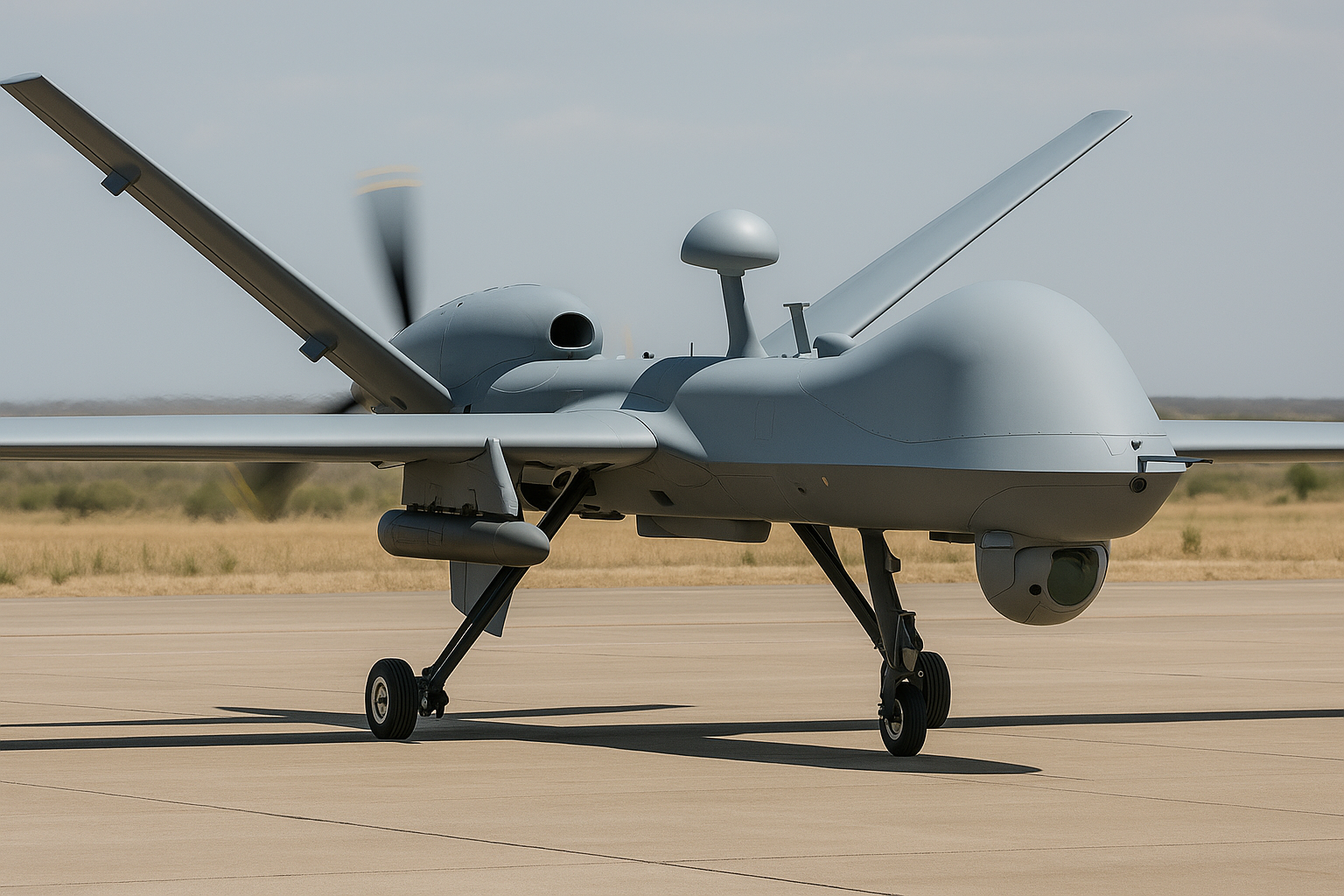The United States has cleared the sale of twenty-two MQ-9B Guardian unmanned aircraft to India, opening a path for New Delhi to field its first long-endurance maritime surveillance fleet just days before Prime Minister Narendra Modi meets President Donald Trump. U.S. officials notified both the Indian government and manufacturer General Atomics of the State Department decision on 21 June, valuing the package at two to three billion dollars. The deal represents a major maritime surveillance boost for India, enabling persistent coverage of critical sea lanes.
Washington frames the approval as a concrete benefit of India’s “Major Defense Partner” status, a label created under the Obama administration but now backed by hardware. The designation grants faster export licensing, limited source-code access, and room for future co-production. Indian negotiators see the drones as a step toward parity with U.S. treaty allies when it comes to technology release.
US – India Drone Deal Expands Strategic Maritime Surveillance
General Atomics sells the Guardian as a maritime cousin of the armed Reaper. The variant carries a multimode surface-search radar, an electro-optical turret, and an automatic identification receiver. It flies higher than most manned patrol aircraft and stays aloft for more than a day. Core performance figures include:
- Endurance – 27 hours
- Service ceiling – 50,000 feet
- Single-mission range – about 6,000 nautical miles
- SeaVue-X radar for surface search
- Encrypted Ku-band line-of-sight and SATCOM links
Indian Navy planners began lobbying for the system in early 2016 after Chinese submarines increased patrols near the Andaman Sea. The Guardians promise 360-degree coverage from the Strait of Hormuz to the Malacca Strait without risking crews or stretching the P-8I fleet. Commanders intend to base the aircraft at INS Rajali in Tamil Nadu and stream raw feeds to the Information Management and Analysis Centre outside Delhi.
Guardian Drones Fill Critical Gaps in India’s Maritime Domain Awareness
The speed of the U.S. decision surprised many Indian officials accustomed to multi-year waits for complex exports. Much of the credit goes to Dr Vivek Lall, now vice president at General Atomics, whose earlier work on the P-8I deal familiarised Indian logisticians with U.S. paperwork. His team walked Ministry of Defence staff through lifecycle cost sheets, allowing the file to reach the Defense Security Cooperation Agency with far fewer back-and-forth exchanges than usual.
Diplomatically, the timing sends a clear signal toward Beijing and Islamabad. Chinese warships escorted an oceanographic vessel through the Indian Ocean twice in early 2017, while Pakistan seeks its own long-endurance drones from China. Although the Guardian carries no weapons, its sensor reach lets India identify surface contacts long before they near its exclusive economic zone. That advantage becomes critical in the context of China’s expanding drone arsenal and growing presence in the Indian Ocean. Pakistani diplomats privately voiced unease, yet U.S. officials counter that an unarmed airframe is defensive by design.
Congress still must weigh in. Under U.S. law, a formal notification triggers a thirty-day review window. Staffers on the Senate Foreign Relations Committee predict smooth passage because India pays cash, the sale underwrites high-skill jobs in at least seven states, and the aircraft advance shared aims for open sea-lanes. If lawmakers raise no objections, contract signature could follow in early autumn.
Components of the MQ-9B Drone Deal
Cost sharing maps out over seven fiscal cycles. India will pay the U.S. Treasury, which then reimburses General Atomics under the Foreign Military Sales channel. The draft Letter of Offer lists twenty-two airframes, two ground stations, eight radars, four spare Honeywell TPE331 engines, five years of initial spares, and training for forty crews. Defence economists in South Block say stretching payments keeps annual pressure on the rupee budget manageable without resorting to supplemental appropriations.
Technology Transfer and “Make in India” Tie-In
New Delhi values technology access almost as much as platform performance. Internal Defence Acquisition Council minutes show that India will request limited source-code release for ground-station interfaces, a predictable price formula for spare engines, and a domestic workshare covering composite control surfaces and radome fabrication. Those elements serve Prime Minister Modi’s “Make in India” push while avoiding delays that plague full indigenisation attempts.
Enabling agreements sit in the background. The Logistics Exchange Memorandum of Agreement entered force last year, granting each side access to the other’s bases for maintenance and replenishment. The Communications Compatibility and Security Agreement remains unsigned but is no longer seen as a deal-breaker. Navy officers believe Guardian control links may become a near-term pilot case once COMCASA language is finalised.
Bilateral Frameworks Boost Guardian Drone Interoperability
Industrial impact inside the United States will be visible. General Atomics builds the MQ-9B at its Poway, California, campus, with key subsystems arriving from New Mexico, North Dakota, and Florida. Company filings claim the Indian order supports roughly two thousand jobs across avionics, composites, and turboprop assembly lines. Congressional delegates from those districts lobbied the State Department to approve the transfer, citing steady work and export revenues.
For India, the operational payoff comes in maritime domain awareness. Each Guardian can loiter above 40,000 feet, free of most weather, and track merchant traffic through sea-state clutter. Software fuses radar returns, optical cues, and AIS beacons into a single picture delivered to coast-guard cutters and P-8I crews. Navy planners also foresee tasking the drones to watch for illegal fishing in the Lakshadweep and Andaman regions, a mission now done by ships that struggle to cover distance and case law violations at once. These expanded missions align with Indian Navy’s readiness upgrades noted by senior leadership earlier this year.
MQ-9B Guardian Drone Missions Extend Beyond Naval Surveillance
Project schedules look ambitious but realistic. If Congress completes its review by late July, contract award could follow in September. General Atomics quotes a twenty-eight-month production span, placing first delivery in spring 2020. Indian pilots will train at the U.S. Air Force’s Holloman syllabus and then transition to a dedicated school at INS Rajali. Defence officials believe the first Indian-crewed operational flight could occur in the second half of 2020, giving planners time to refine doctrine.
Longer term, senior officers hint at integrating the Guardian feeds with the Information Fusion Centre for the Indian Ocean Region, which shares unclassified tracks with partner navies. That arrangement would deepen real-time cooperation among the Quad without broadcasting every sortie to outside observers.
MQ-9B SeaGuardian and SkyGuardian Fleet Expands – March 2025 Update
Eight years have turned a single approval into a far-reaching unmanned partnership. In November 2020, India leased two MQ-9B SeaGuardians for a one-year trial, later extended to four. The drones logged more than 3,500 hours supporting anti-piracy patrols near Somalia and cyclone relief off the eastern coast.
Border clashes with China in mid-2020 pushed New Delhi to seek a tri-service solution rather than a navy-only fleet. By early 2022 Defence Ministry staff drafted a plan for thirty-one MQ-9Bs – fifteen SeaGuardians for the Navy and sixteen SkyGuardians split between the Army and Air Force. The idea gained traction during the June 22 2023 White House summit, where President Biden and Prime Minister Modi welcomed “advanced unmanned aerial capabilities” as part of deeper defence cooperation.
The U.S. State Department formally cleared the expanded package on 1 February 2024. The notice to Congress covered aircraft, mission payloads, mobile ground stations, and five years of spares for up to 3.9 billion dollars.
New Delhi advanced quickly. On 15 October 2024 the Defence Acquisition Council accepted a Letter of Offer and Acceptance for the thirty-one-airframe buy. Reuters pegged final cost just under four billion dollars after offsets.
Industrial Offsets and Joint Production Anchor MQ-9B Expansion
General Atomics agreed to open a global maintenance hub in India and to ship tooling for composite wings to Tata Advanced Systems in Hyderabad. Company vice-president Vivek Lall says twenty-one of the thirty-one drones will roll out of an Indian line beginning in 2027, with component kits sourced from Poway until local suppliers meet quality metrics.
Operational experience already paid off. A leased SeaGuardian ditched in rough seas during a September 2024 anti-piracy watch. Under the lease, General Atomics provided a replacement at no cost, delivering it in February 2025 and keeping the demonstration detachment intact.
Congress completed its review of the thirty-one-airframe case in May 2025 without objections, clearing funds to flow. U.S. lawmakers highlighted that about 1.2 billion dollars in sensor, engine, and data-link work stays inside the United States.
Flight-testing of the Indian-specific Block 70 configuration begins next quarter in California. Indian crews from all three services will cycle through the Holloman syllabus before rotating home to Rajali, where the services share a new ground-station complex. Defence planners aim for an initial operating capability in 2029, followed by dispersed detachments at Port Blair, Car Nicobar, and Leh to cover both ocean and mountain fronts.Officials call the Guardian story proof of how Indo-U.S. defence trade has moved beyond buyer – seller dynamics. US arms sales approvals continue at pace, reflecting broader strategic alignments across regions. Eight years after a quiet cable cleared twenty-two unarmed drones, the roadmap now covers armed variants, shared production, and a regional sustainment hub that anchors supply chains on two continents.
REFERENCE SOURCES:
- https://www.dsca.mil/press-media/major-arms-sales/india-mq-9b-remotely-piloted-aircraft
- https://www.businesstoday.in/latest/economy-politics/story/us-approves-sale-of-22-guardian-drones-to-india-75508-2017-06-23
- https://timesofindia.indiatimes.com/india/us-approves-sale-of-22-guardian-drones-to-india/articleshow/59274194.cms
- https://thediplomat.com/2020/11/india-leases-2-maritime-surveillance-drones-from-us-report/
- https://in.usembassy.gov/joint-statement-from-the-united-states-and-india/
- https://www.reuters.com/world/india-signs-deal-with-us-procure-31-mq-9b-drones-ministry-says-2024-10-15/
- https://www.reuters.com/business/aerospace-defense/us-state-dept-oks-possible-sale-31-armed-drones-india-pentagon-2024-02-01/
- https://news.usni.org/2024/02/01/u-s-approves-potential-3-9b-mq-9b-uav-sale-to-india
- https://economictimes.indiatimes.com/news/defence/india-us-sign-34500-crore-deal-for-31-predator-drones-mro-facilities/articleshow/114241908.cms?from=mdr
- https://www.indianewsnetwork.com/en/20241017/what-4-billion-weaponised-predator-drone-deal-with-the-us-means-for-indian-defence



